How to Run a Cycling and Walking Public Consultation on EngagementHQ
Cycling paths and walkways impact everyone in the community, regardless of whether they actually use the street space. As the nature of how we move around cities is changing, expanding outdoor transportation options will be critical as part of our new normal. Pedestrian paths can help encourage more exercise and less commuting via personal gas-powered vehicles while improving individual well-being and helping to reduce CO2 emissions. It’s a great alternative to public transportation and local governments reap massive savings from an investment in better biking and walking lanes. Use this playbook as a guide to help create your biking and walking public consultation on EngagementHQ.
Planning your Online Public Consultation
To create a plan that works for all stakeholders, you need to hear from a broad range of voices — both from those who will use the street space and those who will be impacted in other ways.
For a biking public consultation, you may have four different audiences:
- those who use the pathway to commute
- those who use the pathway for recreation
- those who drive and will be impacted by changes to roads or parking
- and local business owners who will be impacted if access to their business changes
You can capture this information as a survey question and measure feedback against how participants plan to use the pathways or are affected by them.
When building your description to inform your community, start by communicating the why. Why is this project important to your audience? Lay the groundwork for participants, describe what problem you are trying to solve, what input you need from them, and how their feedback will have an impact.
An example lead-in for a street space consultation might look like:
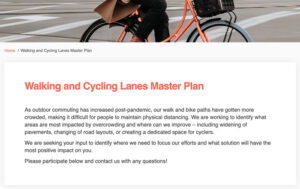
Using Information Tools
 As you create your public consultation within EngagementHQ, you can make use of information tools designed to help you clearly communicate aspects of your project so participants can self educate before they provide input.
As you create your public consultation within EngagementHQ, you can make use of information tools designed to help you clearly communicate aspects of your project so participants can self educate before they provide input.
In this example, you’ll see the City of Winnipeg has used a few different informing tools:
Who’s Listening: let participants know there are real people interested in hearing their feedback.
Timeline: a critical component for street space projects, adding a timeline sets expectations around your process. It’s an easy and visual way to communicate dates for public feedback and what happens when the public consultation closes.
Media: including supporting photos and/or short videos can help communicate different viewpoints, insights, or supporting arguments for consideration.
Important Links: guide discovery and make it easy to find supporting information by providing additional content, either linking to other websites or uploading supporting documents to your project.
Use a Mix of Tools to Diversify Feedback
Different people will choose different ways to get involved with your project. Not everyone will want to complete your survey or go into an in-depth discussion on a forum. By using a mix of engagement and information tools, especially when trying to engage across different audiences, you’ll expand participation and capture more diverse viewpoints from your community.
Create Interactive Maps to Capture Place-based Input with Places
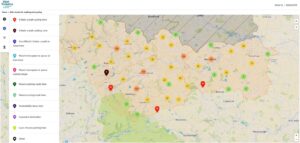
The Places tool is a must for pedestrian pathway consultations. With Places, residents can drop a pin on your map to provide input around a specific geographic location. Within EngagementHQ, you have the ability to define the map area and set boundaries around your consultation, allowing you to keep the conversation focused on specific locations around town where you need input.
Using pin categories and colors, you can visually separate the type of feedback you are seeking, making contributions less work for your participants. You can create as many categories as you need to support your objectives. For instance, you could include a category to identify unsafe sidewalks or lack of bike parking on your map. Once the public consultation is complete, you’ll know where you need to focus improvement efforts, what type of improvements need to be made, and how many participants feel this is a problem that should be addressed.
Add Survey Questions to Each Pin for Deeper Insights
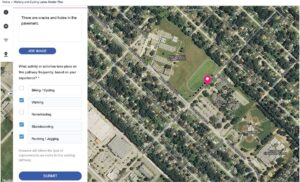
Within EngagementHQ, you can also create survey questions to add to your pins, asking for more context when participants drop a pin. You can customize the type of question, including open-ended essays, dropdowns, and radio button questions, and choose to make the question required or not for participants. For example, if your category pin is ‘sidewalk is unsafe’, you could include a question to understand what repairs might be required.
Brainstorm New Ways to Solve Problems with Ideas
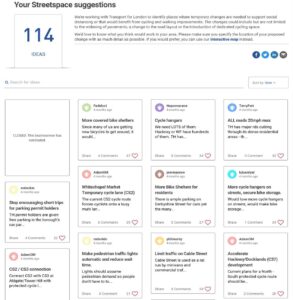
The Ideas tool can be used to hear innovative suggestions from your community, regardless of geographic location, and allows participants to comment and vote on others’ ideas.
The Ideas tool is perfect for early-stage consultation, bringing your community together around potential solutions or new ways of approaching the problem.
Additionally, Ideas can be used as a voting board if you are looking to quantify how many people agree with a certain idea. You can present final ideas for a vote and turn off the ability to add or comment as well.
Capture Structured Feedback with Surveys
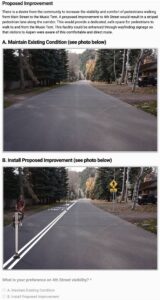 The Surveys tool can support your bike and walking public consultation through guided questioning at any stage of your consultation.
The Surveys tool can support your bike and walking public consultation through guided questioning at any stage of your consultation.
Before you begin writing your survey, you should have a clear picture of the data you need from your consultation. Let those data goals help guide how you write questions and the type of questions you choose.
Creating an engaging survey with images and varying question types can also help increase participation. For bike paths, including imagery to illustrate how an intersection can help your community visualize proposed changes and provide more thoughtful feedback.
Your survey can also capture more demographic information about your participants so you know how different groups of people will be impacted.
Host Deliberative Discussions using the Forum Tool
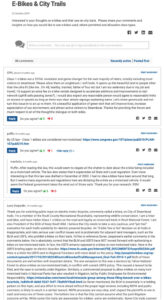 Within your proposed development plan, issues may reveal themselves and need more discussion to really understand the impact on your stakeholders. In the context of bike paths, there may be controversy regarding e-bikes, and if they should be allowed on pedestrian paths. Rather than making this a simple yes / no question in your survey, use the Forum tool to facilitate discussions around what should be allowed on pathways, how fast bikes should be able to go, or whether e-bikes should be excluded.
Within your proposed development plan, issues may reveal themselves and need more discussion to really understand the impact on your stakeholders. In the context of bike paths, there may be controversy regarding e-bikes, and if they should be allowed on pedestrian paths. Rather than making this a simple yes / no question in your survey, use the Forum tool to facilitate discussions around what should be allowed on pathways, how fast bikes should be able to go, or whether e-bikes should be excluded.
Hosting these discussions not only gives residents a chance to provide their opinions, but it also helps them understand other community members and engage in conversation.
Using text analysis and our built-in sentiment analysis tool, you can quickly make sense of this feedback, understanding what discussions are positive, negative, or neutral.
Close the Loop on Community Feedback with the News Feed
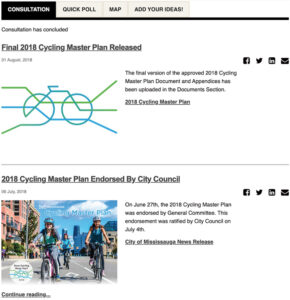
One of the most crucial parts of the public consultation process is closing the loop. Following up with stakeholders who took the time to use their voice will be much more likely to return in the future if they know the impact of their effort.
For bike and walkway projects, you can share the initial plan as well as the aggregate engagement data used to inform the plan with stakeholders. Use the News Feed in EngagementHQ to update participants on the project, and even send a newsletter through the platform to reach your participants through email.
You can see an example bike and walkway project using a mix of engagement and information tools on our demonstration site go.EngagementHQ, we hope you’ll take a minute to see the tools in action, drop a pin, or complete the survey so you see how EngagementHQ works first-hand for this type of public consultation.
